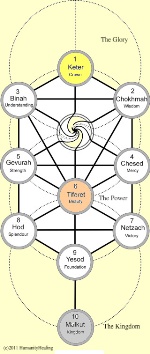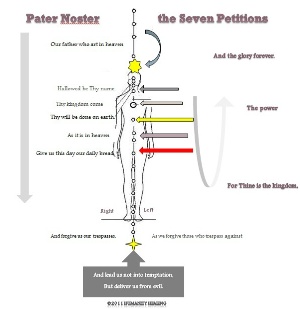The Pater Noster and the Primitive Liturgy

Pater Noster and the Primitive Christian Liturgy
The Jewel of the Christian Faith
 When we talk about Primitive Christian Church, it is important to understand the social and historical context in which this ancient liturgy, especially how prayers, like the Pater Noster, was inserted into the religious tradition. Master Christ Jesus lived in an environment of Jewish Spirituality, and this can be seen throughout his “Testaments” by citations of the Torah and other sacred Jewish texts. It is safe to assume that Jesus may have prayed the Shema[1], the Eighteen Blessings, the Avinu Malkenu and many other prayers and rituals of the Jewish tradition.
When we talk about Primitive Christian Church, it is important to understand the social and historical context in which this ancient liturgy, especially how prayers, like the Pater Noster, was inserted into the religious tradition. Master Christ Jesus lived in an environment of Jewish Spirituality, and this can be seen throughout his “Testaments” by citations of the Torah and other sacred Jewish texts. It is safe to assume that Jesus may have prayed the Shema[1], the Eighteen Blessings, the Avinu Malkenu and many other prayers and rituals of the Jewish tradition.
PATER NOSTER,
Qui es in caelis,
Sanctificetur nomen tuum.
Adveniat regnum tuum.
Fiat voluntas tua, sicut in caelo et in terra.
Panem nostrum quotidianum da nobis hodie,
et dimitte nobis debita nostra
Sicut et nos dimittimus debitoribus nostris.
Et ne nos inducas in tentationem, sed Libera nos a malo.
It is known that Christianity brought a new context to the religious panorama of the ancient world with its new concept and vision of the divinity. For the early Christians, there was just one true God, the Jewish one, but a God who was no longer limited to just the decedents of the old Israelites. The “Lord” was no longer a tribal or a local God, but a universal one. The Christian God would show himself to any man willing to follow his precepts without the distinction of origin and ethnicity. The requirement for the new covenant would be the expression of goodwill of belonging to a new body of people: The Church.
In the subsequent period of the separation and individualization of its faith when the Christian doctrine started to affirm itself as a religious movement, the Pater Noster became an important expression of a new liturgy, even though it still retained some original elements of the Kabbalah and from other mystical/religious sects’ practices of the time, such of the Gnostics.
Originally, the Pater Noster was a dominical prayer, meaning that it had a very special weight upon the other liturgical practices. It is said that the dominical prayers were not taught to everyone because it was seen as a privilege and allowed only to those that had received the benefits of the baptism. For many centuries it was considered one of the jewels of the faith. The Pater Noster became an important expression of a new liturgy, the priest would precede the Pater Noster with the phrase:
“...We dare to say...” recognizing the audacity of repeating the sacred words of the Master.
In the Eastern liturgy, the same reverence and respect were noted, and the Patriarch would then declare: “Thy is dignified, our Lord, permit us to joyfully and without fear to invoke your assistance, Celestial God, as a father would ...Pater Noster...”
The Movement of the Energy of Grace
 Well known inside of Mystical circles as the Prayer of Seven Petitions, the Pater Noster is unlike any other petition prayer. It is a prayer in which we ask the Divine Mind for things we need, primarily spiritual needs, but for physical ones as well. It is a request for descending of Grace. Naturally, Grace is a supreme emanation that needs a proper channel to be manifested. The Channel is the individual or the one that is making the petition. The vibrational tones of the spoken words of the Pater Noster touch every single one of our individual energy centers, the chakras. The recitation of this master formula would bring down not only the benefit of Grace and Heavenly Blessings but also the manifestation of a personal and physical communion with the Divine energies. The Pater Noster was not only regarded as a sacred liturgical formula but even beyond being an act of contrition, it is a declaration of faith and commitment on all levels of one’s being to the sanctified Grace coming from above.
Well known inside of Mystical circles as the Prayer of Seven Petitions, the Pater Noster is unlike any other petition prayer. It is a prayer in which we ask the Divine Mind for things we need, primarily spiritual needs, but for physical ones as well. It is a request for descending of Grace. Naturally, Grace is a supreme emanation that needs a proper channel to be manifested. The Channel is the individual or the one that is making the petition. The vibrational tones of the spoken words of the Pater Noster touch every single one of our individual energy centers, the chakras. The recitation of this master formula would bring down not only the benefit of Grace and Heavenly Blessings but also the manifestation of a personal and physical communion with the Divine energies. The Pater Noster was not only regarded as a sacred liturgical formula but even beyond being an act of contrition, it is a declaration of faith and commitment on all levels of one’s being to the sanctified Grace coming from above.
[1] The Shema is an affirmation of Judaism and a declaration of faith in one God. The obligation to recite the Shema is separate from the obligation to pray and a Jew is obligated to say Shema in the morning and at night (Deut. 6:7).








